From high-end treasures to amusing figurals, Coro is known for creating a vast catalog of jewelry designs. The company made its mark by being one of the largest entities in American costume jewelry history, and the abundance of Coro jewelry available today serves as proof.
When it comes to collecting all this wonderful jewelry, avid vintage jewelry fans seek rare pieces that can sell in the high hundreds and even for thousands. If you’re not quite comfortable with that kind of purchase, don’t worry. This brand offers something within reach of every pocketbook including selections perfect for a young vintage enthusiast’s prom jewelry.
There’s much to learn about this giant in the industry and the products they made, beginning with some basic background.
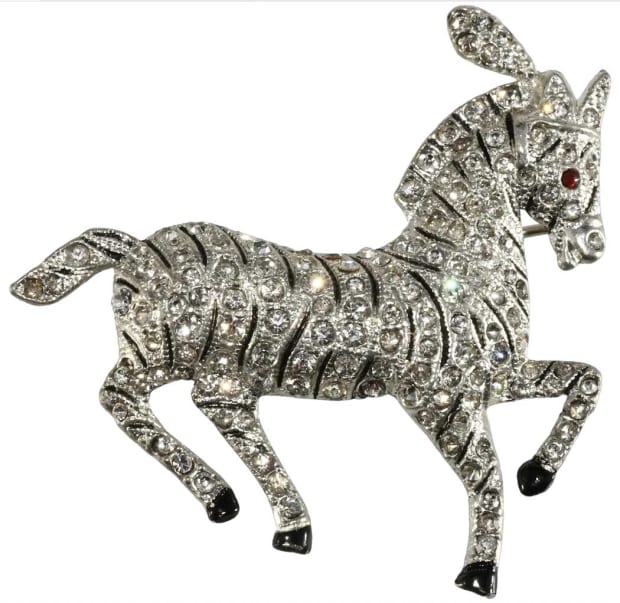
Courtesy Jay B. Siegel
Coro’s History in Brief
Coro contributed to the economy of Providence, Rhode Island—the home of American Costume Jewelry during its golden years—for more than six decades. The company was founded in the early 1900s by Emanuel Cohn and Carl Rosenberger in New York City. Even after Cohn died in 1910, the name Cohn & Rosenberger was still used. The company built a factory in Providence in 1929 that would eventually employ thousands of workers and produce millions of pieces of jewelry.
The name Coro came into use in 1943. By that time, the company was already making some of their most beloved designs. Many from this period are marked CoroCraft and have a winged horse, usually referenced as Pegasus, as part of the logo. A number of these pieces were made of sterling silver in the United States, but some were made in Mexico for Coro at Taller Borda which was owned by Mexican silver master Hector Aguilar.
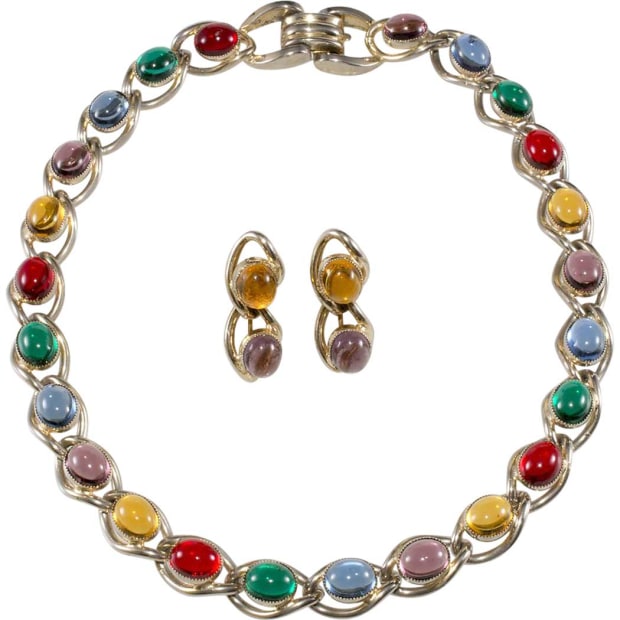
Courtesy Jay B. Siegel
In addition to Coro, Corocraft, and Vendome, the latter of which was a higher end brand of mainly beaded jewelry produced by this firm from the mid-1940s through 1970, there were dozens of other brand and line names used by this company. Some were stamped into the metal while others were denoted on foil hang tags. These names range from Francois and Norseland to Jewelcraft, which was marketed in England. One of the best resources for learning more about Coro’s numerous marks and lines is located on the Costume Jewelry Collectors Int’l website.
Over the course of business, many designers worked for Coro. Some of the most collectible pieces produced during the late 1930s and ‘40s were conceived by Gene Verri. He led the design team beginning in 1935 and worked with the firm until the mid-1960s. Quite a few of Verri’s designs were submitted to the United States Patent and Trademark Office by Adolph Katz. This leads uninformed dealers and collectors to incorrectly attribute them to Katz, but he was a vice president for Coro rather than a designer.
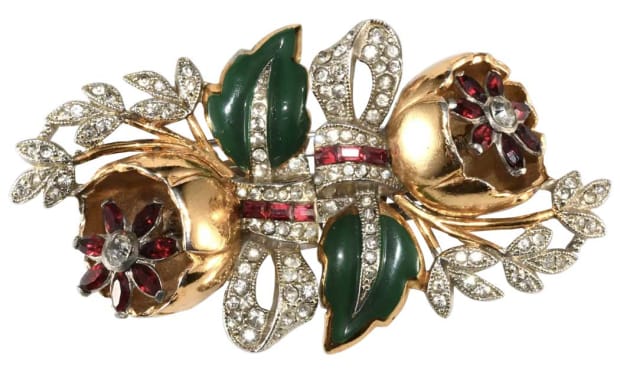
Courtesy Jay B. Siegel
Gerald Rosenberger took over the business in 1957 when his father passed away. He continued to pilot Coro operations in the United States until his death in 1967. The company was sold to a business called Richton Intl. Corp. in 1969 and they made Coro jewelry for another decade. A division in Canada was acquired by a business located in South America and continued to use the Coro name through the early 1990s. All Coro jewelry is now considered to be vintage, which translates to more than 20 years old (as defined by most online vintage marketplaces.)
Desirable Coro Designs
Duettes are some of Coro’s most popular designs. They’re essentially two, or sometimes three, matching clips that are held together by a special bracket that converts them into a single brooch. The clips can be either flat dress clips or double-pronged clips (called fur clips by collectors). The first Duette was patented by Coro in 1935. Early Art Deco examples are certainly collectible, but they’re not as popular with jewelry afficionados as the 1940s examples. Most of those are Verri designs depicting flowers, insects, animals, and people. Some even have trembler elements like the Quivering Camellia example and the even rarer Bell Flower Duette.
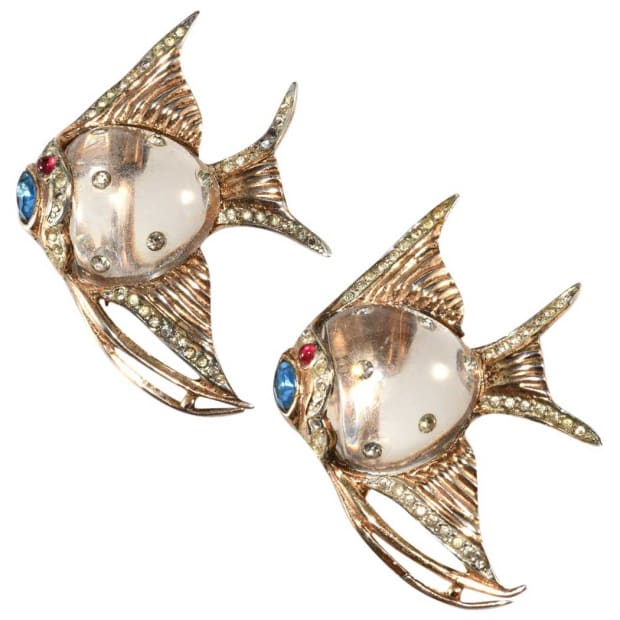
Courtesy Jay B. Siegel
Like Trifari, the other titan manufacturer of costume jewelry in Providence, Coro also produced Jelly Belly jewelry. These pieces, as defined by collectors, are made with clear Lucite bodies surrounded by metal elements. They usually take the form of animals, but Coro also produced flower vases and fortune teller pins with clear plastic elements that fall into this category. One of the most valuable Coro examples is a Pegasus brooch that echoes the firm’s logo. Other highly valued examples—including the flower vase and a fruit-filled cornucopia with a parrot perched on the edge—are decorated with colorful enameling.
A good number of sterling pieces, many of which are marked CoroCraft, also include painted enameling. This includes a fabulous lizard holding a faux pearl in its mouth and figural clips depicting characters like Pinocchio. Some of these amazing designs have been reproduced, though, including Coro’s famed Rock Fish holding a large blue stone in its mouth. Some of the copies are very good, so do your research before investing in them.
Collecting Coro on a Budget
While all those pricey Coro pieces are lovely to contemplate, they’re often out of reach for budding vintage collectors and folks on a budget. One of the best aspects about Coro jewelry, though, is the abundance of affordable alternatives.
Many of the bargain pieces available today were made from the late 1940s through the 1960s. They were reasonably priced and sold quite well so designs from this era are found quite plentifully today. This includes simple daywear necklaces, bracelets, earrings, and coordinating pins. Matching sets were big as indicated in Coro’s numerous ads published in women’s magazines back in the day.
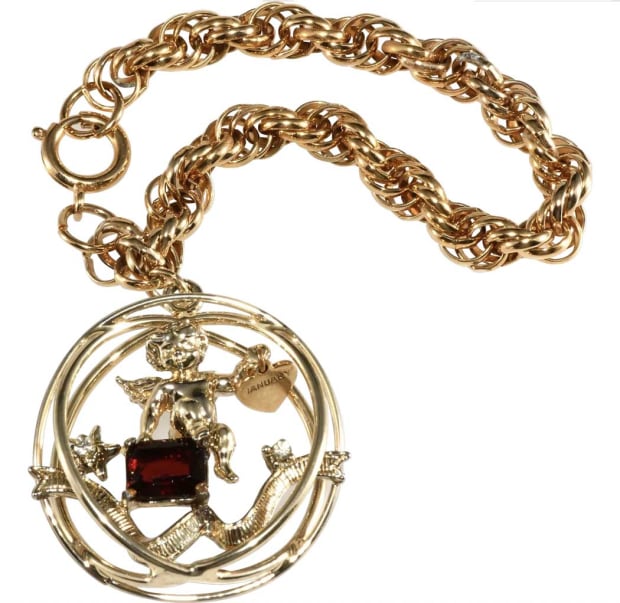
Courtesy Jay B. Siegel
Coro was in the business of producing fashion jewelry. That means the colors, materials, and styles that were fashionable at the time were incorporated into the adornment they marketed. White jewelry, including pieces made with both glass and plastic embellishments, sold well during this era. Light blue was another fashion-forward color choice during the ‘50s. Simulated pearls, confetti Lucite, and moonglow plastics were also widely incorporated into Coro jewelry. Plain gold-plated jewelry was also marketed in competition with other manufacturers like Trifari, Monet, and Napier.
Where can you shop for affordable Coro designs? Thrift stores and estate sales are good places to start. Most online vintage venues and auction sites have numerous pieces available, too. A recent search on RubyLane.com, in fact, yielded literally hundreds of Coro choices in the $25-49 price range. If you want to be tempted by some of those pricier choices selling in the hundreds, some of those are available online, too.
You May Also Like:
How to Identify Juliana Jewelry
How to Identify Unmarked Costume Jewelry
Who Are The Greatest Costume Jewelry Designers? Here’s a List








